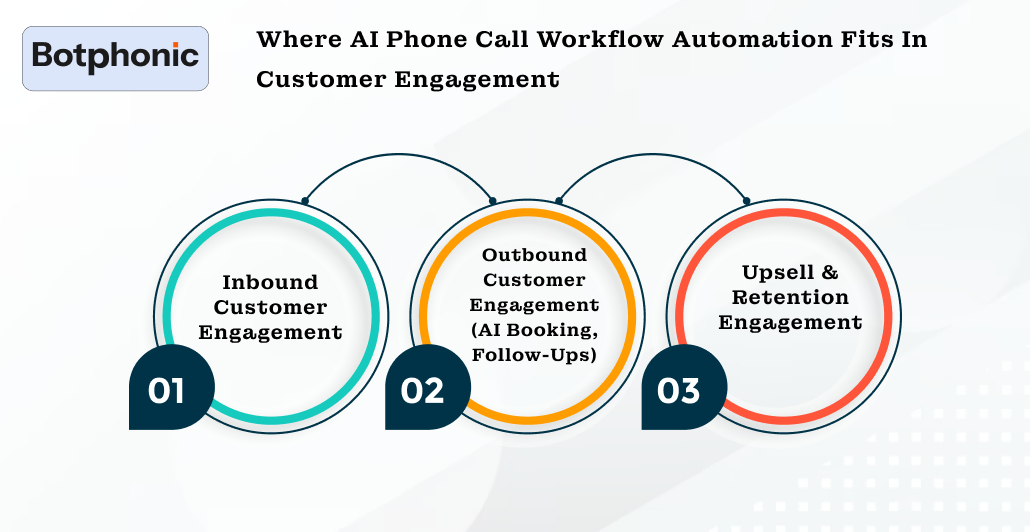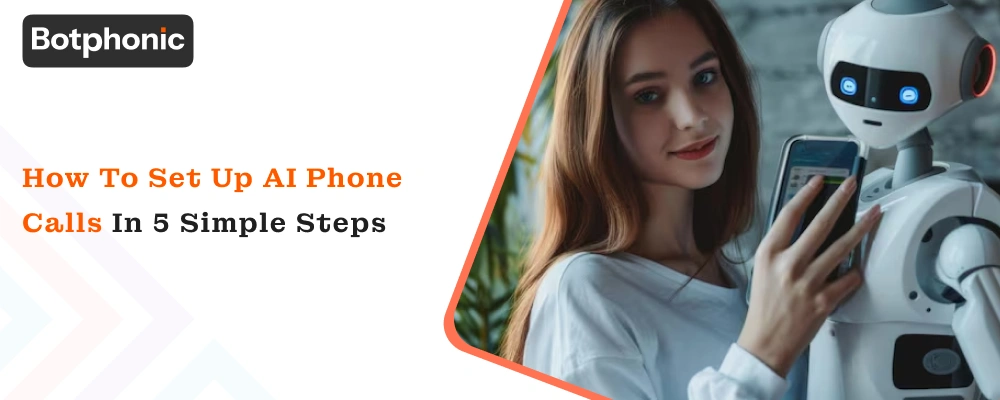
Summarize Content With:
Summary
This blog discusses the use of AI phone call workflow automation to enhance customer engagement. We look into how a system like Botphonic AI can combine an AI call assistant, AI booking features, and smart routing to both improve productivity and create a better customer experience.
Key Takeaways
- AI phone call workflow automation is a system that can handle both inbound and outbound calls in a highly efficient manner, resulting in reduced costs and waiting times.
- The AI call assistant is designed to guide routine customer tasks, such as appointment booking, lead qualification, and follow-ups.
- Voice AI integration with workflow tools ensures complete automation, from the moment the call is made to the CRM action.
- It is very important to choose the right platform (with features like simple no-code setup, multilingual support, and analytics) if you want to be successful.
Introduction
What if a customer called your business at 10 pm and got an immediate, helpful voice? That voice not only books the appointment but also updates your system and, if necessary, hands off only the complex cases to a human. Far from being a scenario from science fiction, it is now possible with AI phone call workflow automation to automate customer engagement with voice agents that feel human.
The blog will explore how this is achieved, why it is significant, and how you can utilize Botphonic AI to streamline your call workflows.
What is AI Phone Call Workflow Automation?
AI phone call workflow automation is essentially a voice-based AI that automatically handles call-related tasks. The technology in it involves speech recognition (what is spoken by the user), natural language understanding (figuring out the user’s intent), voice synthesis (talking back to the user in a human-like manner), and workflow logic (sending the call to the right person, booking, and updating systems).
AI can communicate with both people who call the company (customers calling you) and those the company wants to contact (you calling a customer or a lead). However, in both cases, communications are handled by automated voice agents.
Imagine if it were to happen like this: a customer calls your number → AI agent picks up → asks a few questions → if the reply is “I want to book an appointment,” it triggers the booking workflow → updates your calendar/CRM → sends confirmation. So, this whole appointment “thing” happens without any human intervention at all. Essentially, that is what “AI phone call workflow automation” means.
Why It Matters:
- By AI, there will be no waiting time or missed calls, because it is available 24 hours a day, 7 days a week
- Manual intervention by human agents is not completely ruled out; instead, they must deal with difficult situations, while routine tasks are taken care of by AI.
- Moreover, the company gains more trustworthiness as well, since the brand voice is consistent and every call is handled according to the established logic.
- Not only does it integrate with other services (such as CRM, calendars, or booking tools), but it can also be a truly user-friendly, end-to-end process.
Key Components of an AI Call Workflow System

Building an effective AI phone call workflow automation requires a few key components to work seamlessly together. What are those components, and why do they matter? Let’s find out.
1. AI Call Assistant (Voice Agent)
This is a voice-based AI that the customers talk to, the AI understands the speech, analyses it, and replies with a similar human-like voice in the same language and slang. For example, Botphonic AI presents its assistant as:
Why this matters:
- The first interface with customers is just like a human. If it sounds robotic or can’t handle the conversation, the customers become frustrated and drop out.
- Call volume is not an issue since the AI assistant can take calls 24/7 without breaks.
- It achieves precision in figuring out the caller’s needs (reservation, support, marketing).
2. Workflow Logic & Automation Engine
After recognising the intent of the caller, the decision layer decides on the next step. It could be to change the call direction, take the appointment, get a human to help, or store the information. For instance, Botphonic states “automate calls with AI,” “schedule an appointment,” and “update calendar/sheet” in its guide.
Why this matters:
- Without definite logical automation, verbal communication becomes a mere recording, which is followed by human intervention (a slower process).
- The good workflow premise implies that the system actually works through all stages of the process: call → action → feedback → record.
- It lessens the chances of mistakes, and the number of manual operations is decreased.
3. Integration with Systems (CRM / Calendar / Booking / Analytics)
The AI call transaction has to be well-programmed with your business systems. The voice agent gets the data and can fill in the details for your CRM and can take care of calendars and deliver emails or SMS if needed. “Botphonic” refers to integrations:
“Zoho Integration,” “Salesforce Integration,” “Zapier Integration,” and “HubSpot Integration.”
Why this matters:
- The information collect during the conversation is transform into steps that can be taken (lead record, booking confirmation).
- This is what keeps relations strong between tools: no separate data banks.
- Analytics are made possible: you get to monitor call metrics, origin, conversion, and satisfaction.
4. Analytics & Feedback Loop
Each conversation is a potential source of information: what was ask, how long the conversation was, whether it was handed over to a human, whether the reservation was done successfully, and the sentiment of the caller. Analytics is the main engine that drives workflow refinement. Some of the topics covered in Botphonic’s blog are “Conversation Analytics,” “Sentiment Analysis”, and “Feedback Collection.”
Why this matters:
- It detects the points where AI got things wrong and thereby helps improve the user interface or grammar by providing better prompts.
- It serves as an ROI meter: total number of calls automated, transfers, and expenses averted.
- Enhances customer experience with fewer wrong transfers and faster handling.
Where AI Phone Call Workflow Automation Fits in Customer Engagement

After finding out all the necessary attributes, it will be interesting to understand at which point the AI-Powered Phone Systems call workflow automation interacts with the customer engagement lifecycle: first touch, conversion, and retention.
1. Inbound Customer Engagement
It is generally understood that customers are encumbering the business with their calls, most of which would be for general inquiry, booking, support, or feedback. The AI voice agents are the ones that will lighten the routine load. For instance:
- A communication from a customer goes like this: “What time are you open?” → AI fulfils the role.
- A patient calls to make an appointment → The AI queries the patient, finds the available slot, and books it.
- A customer makes a call out of hours to the business → The AI handles it and updates the internal system.
- Instant engagement is what the customer merits with this development.
2. Outbound Customer Engagement (AI Booking, Follow-ups)
Just as the inbound ones, outbound voice AI is extremely potent. For example, what if you have leads or incomplete bookings: an AI agent calling them, inquiring whether they want to reschedule, qualifying them, and booking appointments. Botphonic describes outbound capabilities (“Outbound calls with AI voice agents”).
This insinuates that your engagement is of a proactive rather than a reactive nature, contacting leads and automatically following up, and thus lessening the drop-off rate.
3. Upsell & Retention Engagement
Engagement does not stop once a customer is in your business’s system. AI voice agents are able to:
- Notify citizens of their upcoming appointments.
- Provide information about new services or upgrades through a phone call.
- Survey satisfaction level and collect feedback.
- If necessary, provide routes to human partners for high-value tasks.
AI workflow automation is the reason that there is minimal human intervention necessary for all these interactions to take place at the right time. A voice AI system was the sole agent in 88.4% of the calls, thus creating a situation where the staff could be engaged in more valuable activities.”
What if each call resulted in a sale, appointment, or customer satisfaction even when you are not awake?
Schedule a live demo with Botphonic AI and understand the impact of smart telephony automation on your business growth.
Request a Free DemoFinal Thoughts
We have the knowledge of the transformation of customer engagement via phone call automation of workflow by using an AI call assistant, workflow logic, system integrations, and analytics. It’s clear how inbound, outbound, and retention calls can be automated, leading to not only improved customer experience but also cost savings, increased conversion, and data-driven insights. We also discussed selecting a platform and provided a Botphonic.AI -specific action plan.
The time to move is now. The tech is not in its infancy anymore. The demand for a fast, human-like, and always available customer service is something the customers really expect. So, if your goal is to cut down on the costs, get more bookings, or simply increase customer engagement. Just install an AI phone call workflow automation system without further delay.

